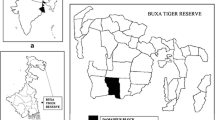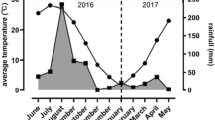Abstract
In 1972 Arashiyama West troop of Japanese macaques was transplanted to southcentral United States and kept in semi-free ranging conditions. The new environment provided an opportunity to assess aspects of the species' adaptive potential. About 1,500 feeding observations were made monthly over 6.5 months. Unlimited provisioned food was available, but monkeys utilized native plants immediately and use increased until it included 50+ % of the diet by weight. Shrubs provided 75% of foods in first month and 32% thereafter. Sorghum comprised 25% in May–July. Soil, arthropods, fungi, bulbs, and roots each comprised less 5%. Between 21 and 37 foods were utilized monthly. Monthly food uses corresponded to availability. Many food plants required unique handling by monkeys. Four general adaptive responses to potential foods are described. Evolution has clearly shaped the Japanese macaque into a highly omnivorous and behaviorally flexible animal.
Similar content being viewed by others
References
Casey, D. E. &T. W. Clark, 1976. Some spacing relations among the central males of a transplanted troop of Japanese macaques (Arashiyama West).Primates, 17: 443–450.
Clark, T. M. &T. Mano, 1975. Transplantation and adaptation of a troop of Japanese macaques to a Texas brushland habitat. In:Contemporary Primatology,S. Kondo,M. Kawai, &A. Ehara (eds.), S. Karger, Basel, pp. 358–361.
Estrada, A. &R. Estrada, 1976. Establishment of a free-ranging colony of stumptail macaques (Macaca arctoides): Relations to the ecology 1.Primates, 17: 337–355.
Hazama, N., 1968.Plants of Arashiyama and Plants Eaten by Wild Japanese Monkeys. Iwatayama Monkey Park Publ., Kyoto.
Izawa, K. &T. Nishida, 1968. Monkeys living in the northern limits of their distribution.Primates, 4(2): 67–88.
Kawai, M., 1960. A field experiment on the process of group formation in the Japanese monkey (Macaca fuscata), and the releasing of the group at Ohirayama.Primates, 2: 181–255.
Morrison, J. S. &E. W. Menzel, Jr., 1972. Adaptation of a free-ranging rhesus monkey group to division and transplantation.Wildl. Monogr., 31: 1–78.
Struhsaker, T. T., 1974. Correlates of ranging behavior in a group of red colobus monkeys (Colobus badius tephrosceles).Amer. Zool., 14: 177–184.
Suzuki, A., 1965. An ecological study of wild Japanese monkeys in snowy areas—Focused on their food habits.Primates, 6: 31–72.
Waser, P. M., 1975. Monthly variations in feeding and activity patterns of the mangabey,Cercocebus albigena (Lyddeker).East Afr. Wildl. J., 13: 249–263.
Author information
Authors and Affiliations
About this article
Cite this article
Clark, T.W. Food adaptations of a transplanted Japanese macaque troop (Arashiyama West). Primates 20, 399–410 (1979). https://doi.org/10.1007/BF02373391
Received:
Accepted:
Issue Date:
DOI: https://doi.org/10.1007/BF02373391




